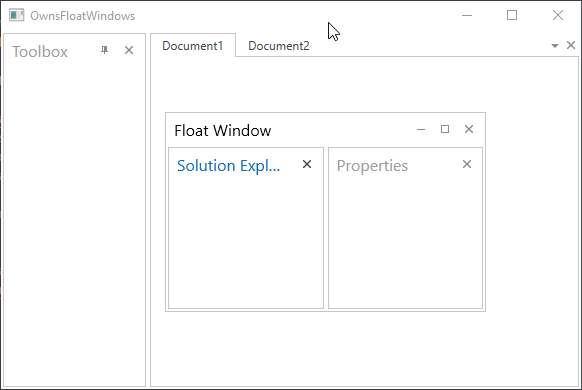DockLayoutManager.OwnsFloatWindows Property
Gets or sets whether float windows are automatically minimized/restored along with their parent DockLayoutManager. This is a dependency property.
Namespace: DevExpress.Xpf.Docking
Assembly: DevExpress.Xpf.Docking.v25.2.dll
Declaration
Property Value
| Type | Description |
|---|---|
| Boolean |
|
Remarks
Initially, DockLayoutManager explicitly owns all its float windows. All the DockLayoutManager‘s floating windows are displayed above the window and cannot be hidden separately. When the DockLayoutManager is minimized, all its float windows are minimized as well. You cannot restore an individual float window when its parent DockLayoutManager is minimized.
Set the OwnsFloatWindows property to false to allow float windows to be independent from the DockLayoutManager.
In this case, your users can minimize the DockLayoutManager and its visible float windows separately or arrange DockLayoutManager windows above this DockLayoutManager‘s float windows.
Example
The following code sample sets the OwnsFloatWindows property to false to make the DockLayoutManager handle its FloatGroups as separate windows:
<Window ...
xmlns:dxdo="http://schemas.devexpress.com/winfx/2008/xaml/docking">
<dxdo:DockLayoutManager FloatingMode="Desktop" OwnsFloatWindows="False">
<dxdo:LayoutGroup x:Name="LayoutRoot" Orientation="Vertical">
<dxdo:LayoutGroup>
<dxdo:LayoutPanel Caption="Toolbox" />
<dxdo:DocumentGroup>
<dxdo:DocumentPanel Caption="Document1"/>
<dxdo:DocumentPanel Caption="Document2" />
</dxdo:DocumentGroup>
</dxdo:LayoutGroup>
</dxdo:LayoutGroup>
<dxdo:DockLayoutManager.FloatGroups>
<dxdo:FloatGroup Caption="Float Window">
<dxdo:LayoutPanel Caption="Solution Explorer" />
<dxdo:LayoutPanel Caption="Properties" />
</dxdo:FloatGroup>
</dxdo:DockLayoutManager.FloatGroups>
</dxdo:DockLayoutManager>
</Window>

Float Window Taskbar Icon
You can specify the DockLayoutManager.ShowFloatWindowsInTaskbar property to display each float window’s thumbnail in the Microsoft Windows Taskbar.
Note
When the OwnsFloatWindows property is true, float windows do not display their taskbar thumbnails when their parent DockLayoutManager is minimized, even if the DockLayoutManager.ShowFloatWindowsInTaskbar property is set to true. This happens because the OwnsFloatWindows property makes it impossible to restore individual float windows without restoring the DockLayoutManager.